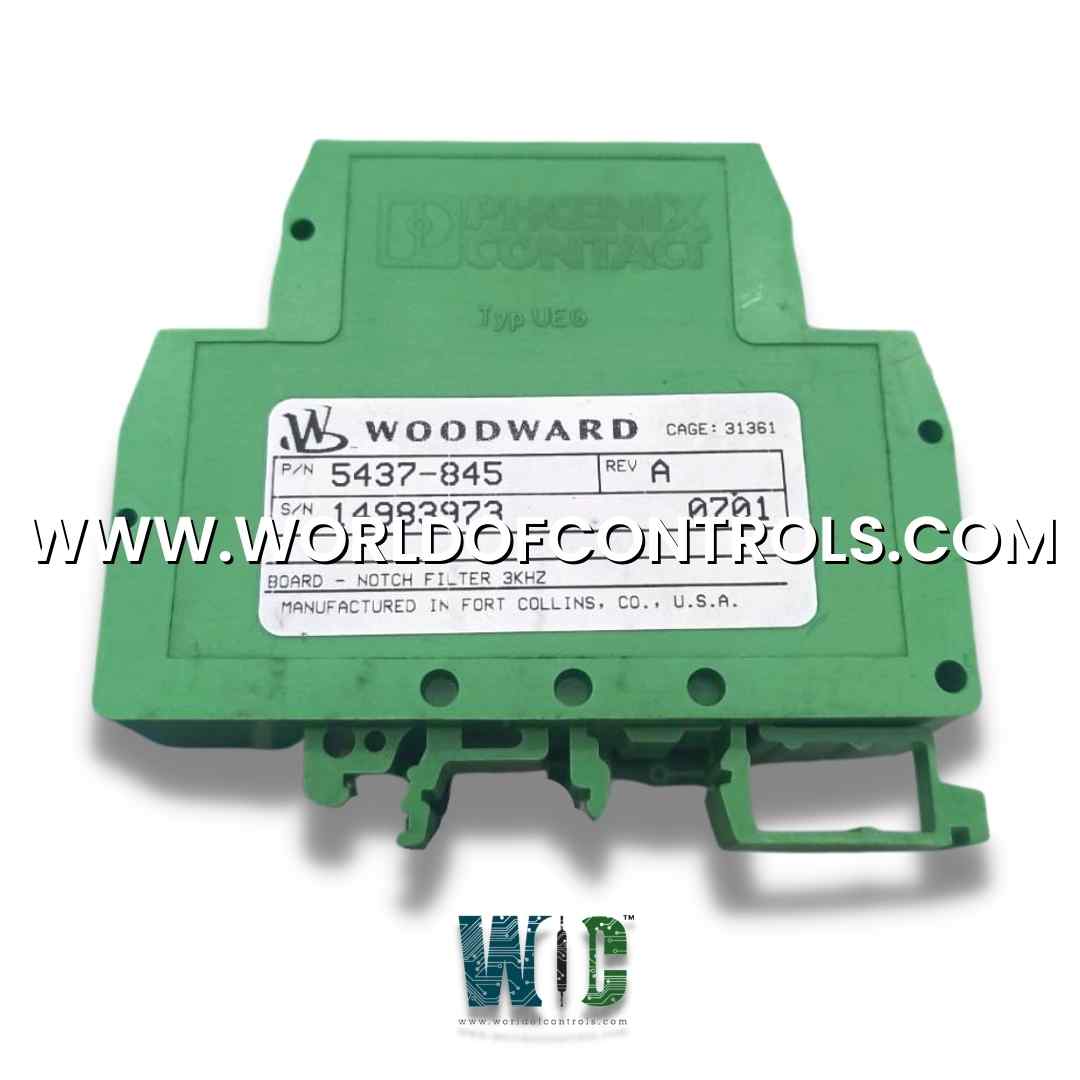SPECIFICATIONS
Part Number: 5437-845
Manufacturer: Woodward
Product type: Field Terminal Module
Dimension: 6.25 x 3.50 x 2.75
Frequency: 3Khz
Repair: 3-7 Day
Availability: In Stock
Weight: 0.55 lbs
Country of Manufacture: United States (USA)
Functional Description
5437-845 is a Notch Filter Module developed by Woodward. It is also known as a band-stop filter or a band-reject filter. It is is designed to target and suppress signals within a narrow frequency band, centered around the desired frequency. The primary purpose is to address issues such as bothersome hums or annoying buzzes that can be present in electronic systems or audio equipment. By implementing this module, users can achieve a significant reduction in the amplitude or intensity of the unwanted signal, ensuring a cleaner and more accurate output.
Features
- It operates on the principle of attenuation, employing advanced circuitry to create a deep suppression of signals within the specified frequency range. This is achieved by precisely tuning the module to the target frequency, allowing it to effectively discriminate against and filter out the unwanted noise or interference.
- The module is engineered with a high level of precision to ensure optimal performance. It is designed to maintain a narrow bandwidth around the center frequency, ensuring that only signals within the desired range are attenuated while leaving the rest of the frequency spectrum unaffected. This selective filtering capability makes the module highly versatile and adaptable to various applications.
- With its robust design and reliable performance, the module is well-suited for integration into a wide range of systems and equipment. It can be utilized in audio systems, communication devices, electronic instruments, and other setups where precise noise reduction is required.
Characteristics
- Designed to attenuate or reject signals within a specific frequency range.
- Refers to the amount of attenuation achieved at the target frequency. It indicates how effectively the notch filter module can suppress the unwanted signal. Higher notch depth values correspond to more effective rejection of the target frequency.
- The bandwidth of a notch filter module defines the width of the frequency range where the attenuation occurs. It indicates the range of frequencies around the target frequency that will be suppressed by the filter.
- Have specific input and output impedance requirements to ensure proper signal matching and compatibility with the rest of the system or circuit.
- Signal level handling- The module's specifications should include information about the maximum signal level or power that the notch filter can handle without distortion or damage.
- Modules may have specific power supply requirements, such as voltage levels or current consumption.
System Specifications
- The MicroNetTM control is built around a six-slot modular chassis (block). Each block is made up of a premolded cage with a fan for cooling and a temperature switch for detecting high temperatures. The chassis are cooled by forced air, and to maintain proper air flow, a module or a module blank must be installed in each slot. When power is applied to the system, the fans start up.
- The MicroNet TMR control chassis has eighteen slots and is made up of three blocks with a motherboard inserted in the back to connect the fans, switches, power supply chassis, and all three kernels. For connector specification and data transfer, the modules employ the VERSAmodule Eurocard (VME) bus standard.
- The logic and power connections between kernels and slots are made via an etched-circuit motherboard. I/O connections are made by running cables from the front of the boards to the cabinet's field termination modules (FTMs).
World of Controls has the most comprehensive selection of GE and Woodward components. Our professionals are available to help you with your requirements at any time. If you require any additional information, please contact WOC immediately.
Frequently Asked Questions
What is 5437-845?
It is a Field Terminal Module developed by Woodward.
What is the MicroNetTM control?
The MicroNetTM control is a control system built around a modular chassis that is designed for industrial applications. It provides control and monitoring functionalities for various processes.
How is the control chassis structured?
The MicroNetTM control chassis is built as a six-slot modular block. It consists of premolded cages that house the modules, with each cage equipped with a fan for cooling and a temperature switch for detecting high temperatures. The chassis are cooled by forced air circulation.
What is the purpose of module blanks in the chassis?
To maintain proper air flow and cooling within the chassis, it is necessary to have a module or a module blank installed in each slot. The module blanks are placeholders that occupy empty slots, ensuring that the air flows correctly through the chassis.
